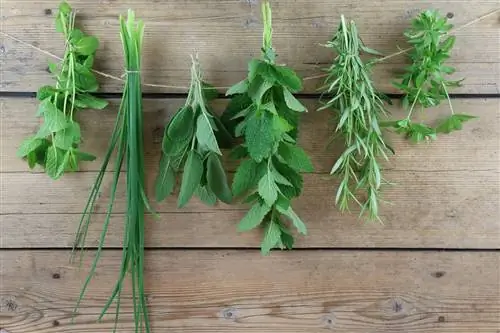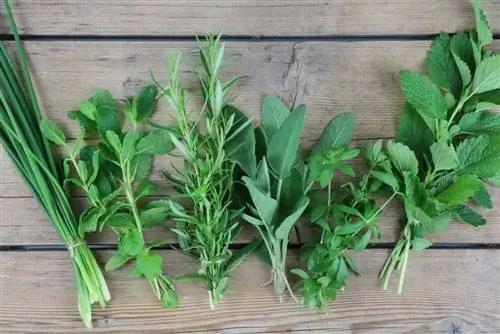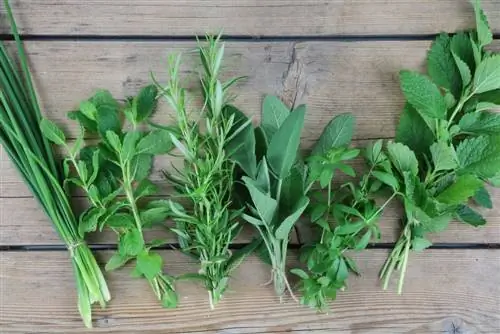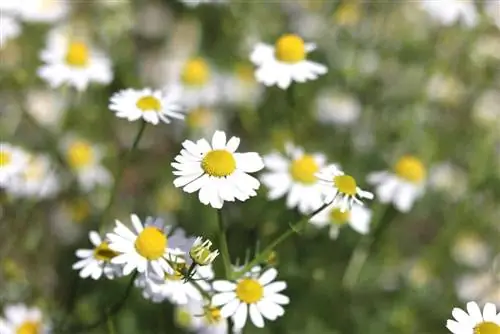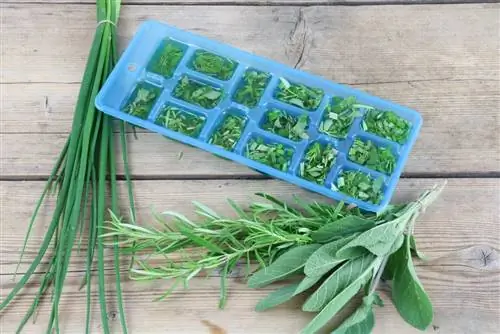- Author admin [email protected].
- Public 2023-12-17 03:39.
- Last modified 2025-01-24 12:45.
The list of culinary herbs is long. There is the right herb for almost every dish. You can enjoy them fresh or dry them and use them to make your very own spice creations.
Harvest in time
In order to preserve and use the complete aroma and full taste of these spice plants, the right harvest time is important. Many culinary herbs develop their most intense aroma before flowering and should then be harvested as quickly as possible. The aroma is usually lost quickly during flowering. Of course they are still edible. Ideally, you should collect them on a sunny day as soon as the morning dew has dried off. After harvesting, they can be air dried, dried in a dehydrator or oven.
In the air
Drying is the most popular and well-known method of preserving aromatic plants. Under no circumstances should you wash them, only remove dirt by shaking them or using your hands. If you wash them, the quality of the plants is affected and the drying process is delayed. Air drying is probably the most gentle of all types of drying, but also the one that takes the most time.
- clean the fresh herb in the first step
- then tie them together loosely into small bundles
- do not squeeze or squeeze, hang upside down
- don't hang too close for ventilation
- in a warm, shady and wind-protected place
- Do not expose items to be dried to direct sunlight
- ideal ambient temperature between 20 and 30 degrees
- not warmer than 35 degrees, essential oils could evaporate
- optimal drying time between two and four days
- dried through when the plants have a paper-like consistency
Unfortunately, not all culinary herbs are suitable for this method of preservation. Species with soft leaves such as parsley, chives, basil, dill, cress or lovage are best frozen. They would lose most of their flavor during the drying process. Peppermint, rosemary, sage, thyme, savory, marjoram, oregano, lavender as well as chamomile, mugwort and woodruff are very suitable.
In the dehydrator
In the dehydrator, drying should be particularly gentle due to the low temperatures. Such devices usually work in a temperature range between 30 and 70 degrees. It would therefore be an advantage if the dehydrator had an appropriate temperature controller. With the right setting, the water is gently removed from the herbs and the loss of aroma is limited. Temperatures of 40 degrees are usually optimal. Many culinary herbs are simply no longer edible at higher temperatures.
- only use intact plants for drying
- remove yellow or rotten areas
- wash the herb as opposed to air drying
- dry well with kitchen roll
- distribute evenly on the drying rack of the dehydrator
- Make sure there is enough distance, do not lay on top of each other
- only shred after drying
- Drying process takes about two to three hours
Tip:
Mediterranean herbs such as oregano, sage or marjoram only develop their intense aroma, smell and taste after drying.
In the oven
This method is quite expensive due to the long drying time and the associated electricity consumption. Here too, distribute the collected material onto a baking tray lined with baking paper without the plants touching each other and place them in the preheated oven. They are then dried at 50-60 degrees for two to three hours. During drying, the oven door should be left slightly open to allow moisture to escape. It's best to just stick a wooden spoon or something similar in the door.
Tip:
When drying in the oven, you usually have to expect a slight loss of aroma.
Make your own spice mixes
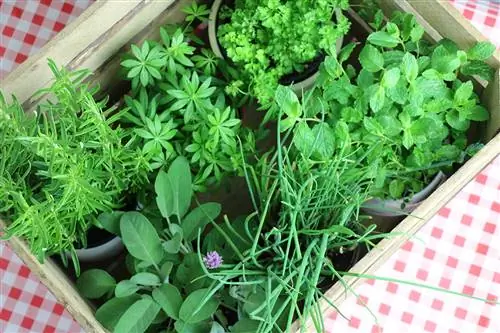
Homemade spice mixtures are very trendy. All the better if you grew and harvested the herb yourself. The great thing about it is, on the one hand, that you know exactly what's in it and, on the other hand, you learn a lot about the subtle differences between the individual herbal mixtures. There are hardly any limits to your own imagination and creativity, as the following examples show:
Herbs of Provence
- 1 tbsp rosemary
- 1 tbsp oregano
- 1 tbsp thyme
- 1 tbsp basil
- 1 tbsp savory
Depending on your needs, you can refine this mixture with laurel, marjoram, chervil, anise, fennel, tarragon, sage and/or lovage. These spices or herb mixtures go well with various dishes, including salad.
Italian spice mix
- 1 tbsp thyme
- 1 tbsp rosemary
- 1 tbsp sage
- 2 tbsp basil
- 2 tbsp oregano
This mixture can be supplemented or replaced with parsley, mint, dill or nutmeg, depending on what you would like to have in it.
Soup seasoning
- 2 tsp thyme
- 3 tsp parsley
- 3 tsp chives
- 4tsp chervil
- 6 tsp lovage
All these herbal plants are known for their intense aroma and delicious taste. If you add celery, fresh leeks and carrots to it, nothing stands in the way of a delicious stew.
Herbal s alt
- Basil
- Rosemary
- Oregano
- Sage
- Thyme
The culinary herbs mentioned are mixed with s alt in aratio 1:10 (10 g herb and 100 g s alt). Depending on your taste and willingness to experiment, you can add lavender and mint, but only in small quantities, as both spices have a very intense aroma, which could easily mask that of the others.

